Ventilation device in the bath: technical options and popular schemes
Ventilation for a bath is vital. Humid hot air is quickly filled with carbon dioxide exhaled by washing people and it becomes truly dangerous for them. Efficient air exchange is also necessary to maintain a comfortable temperature and to extend the life of the building.
That is why a competent ventilation device in the bath becomes a priority for designers and builders.
This article will discuss how to properly equip ventilation in the bath, its varieties. We also give popular ventilation schemes for the bath.
The content of the article:
Ventilation: what happens?
The ventilation itself is designed to provide continuous air circulation inside the building. For this purpose, air ducts of various shapes and lengths, ending in openings inside the building, are used. There are two types of such holes. Supply air is designed to supply air masses from the street. Exhaust openings are used to remove carbon-enriched air.
The correct relative position of the openings for the inflow and exhaust is very important. If it is built incorrectly, effective air exchange cannot be achieved. This location largely depends on the type of ventilation selected, there may be only two.
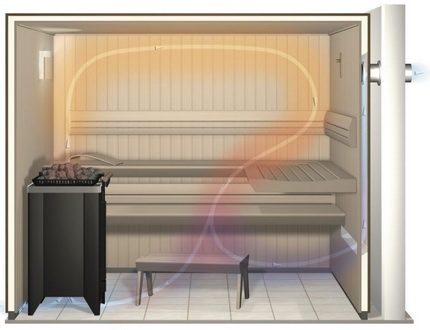
Natural ventilation
Natural circulation of air flows occurs due to the difference in pressure and temperature outside the bath and inside it. The heated air masses, according to the principle of convection, have a lower mass and, accordingly, always rise under the ceiling.
The colder air, on the contrary, is heavier, so it sinks to the floor. Due to this, there is a continuous circulation of air mass.
How effective it will be depends on the number and location of the openings for the hood and supply. Given that the main task of bath ventilation is to ensure the influx of fresh air, and it is colder, and at the same time remove the waste warm, the supply air holes are always located below the exhaust.
Thus, the heated masses of air rise and are forced out through the hood to the street colder.
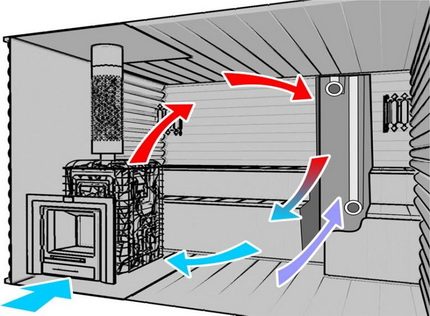
Thus, it is possible to create indoor pressure or vacuum, which, in turn, draws cool air through the supply openings from the street. It warms up, rises up and the cycle repeats.
You need to know that the natural circulation in the bath is not only through special openings. For example, the inflow of air masses can be well carried out through ajar windows or doors and through the crowns of chopped buildings.
Outflow of air may additionally occur through a chimney or window. To control air exchange and prevent drafts, ventilation holes of all types are necessarily equipped with adjustable grilles or shutters.
If the bath is designed and built correctly, natural air exchange may be quite enough to ensure effective ventilation.
Forced ventilation
In cases where natural circulation is clearly not enough, a forced air exchange system is used. The principle of its action is that fans are mounted on the vents that accelerate the movement of air.
They can be installed on both exhaust and air inlets. In the first case, the device will push the exhaust air, and in the second, on the contrary, draw in air masses.
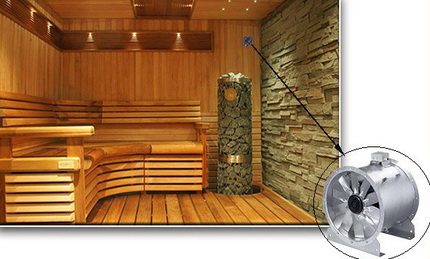
To regulate the intensity of circulation of air masses, blinds and closing grilles can be used. It is important to understand that if holes of the same type are opened more, the flow rate will increase significantly and a draft will appear. The best option is about the same size holes, which will ensure the most smooth circulation of flows.
Depending on the purpose of the installed fans, there are three types of forced ventilation:
- Exhaust. It is realized by installing electrical equipment in the exhaust openings. Effectively reduces the pressure in the room, while creating a vacuum, offset by a powerful influx of air. It removes excess moisture, odors, harmful gases well.
- Supply. Fans are placed in the supply openings, due to which the pressure in the room increases and the exhaust air masses are squeezed out of it. The minus of the system is the active supply of cold air. To maintain the temperature in the room, it is desirable to heat it.
- Supply and exhaust. This is a combined system that combines both of the above methods. The most difficult option for design, but it is also the most effective. It can be fully mechanized, and transferred to automatic control.
The choice of type of ventilation for your bath largely depends on the type of construction. For sealed frame constructions, foam block and brick structures, it is optimal to choose the forced option.
But for traditional Russian timber or log baths, natural ventilation is well suited.True, you need to understand that it will work effectively only if the system is properly designed.
Nuances of ventilation design
For a bathhouse, as for no other structure, effective ventilation is extremely important. This is especially true for the steam room. If mistakes are made in the design, the room temperature will drop sharply, which will lead to discomfort and excessive fuel consumption. But this is not the worst.
With a lack of supply mass, the concentration of carbon dioxide in the air will increase rapidly, and this is a direct threat to health and even life.
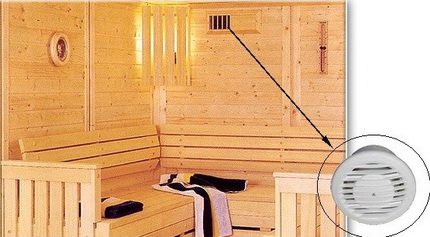
That is why the competent design of bath ventilation is considered very important. You need to understand that you need to do this not in the course of construction, but worse after the start of operation of the building. The ventilation system is always calculated at the design stage of the bath.
This is due to the need to build duct system and ventilation ducts to ensure efficient air exchange.
Moreover, these elements should be present not only in the steam room, but also in all bath rooms: shower, washing, locker room, etc. The effectiveness of bath ventilation depends on two determining factors. The first is the number and size of vent holes.
All this is determined solely by the volume of the room. It is important to understand that the design dimensions of the hole should be maximum. To change it, an adjustable grille is subsequently mounted.
When determining the size of the holes, special formulas are used. However, the average value can be calculated. The ventilation opening should have an area of 24 square meters. cm per cubic meter of area served premises.
This is true for the air inlet. The exhaust opening should have a slightly larger size, which will provide good traction. It is important not to make a mistake and not to make the supply aperture too large.
In this case, the room will be very poorly heated, which will lead to an unjustified overspending of energy resources. If the openings are too small, there is a danger that the humidity and concentration of carbon monoxide will be constantly increased. That is why it is desirable that the calculations be carried out by a competent specialist.
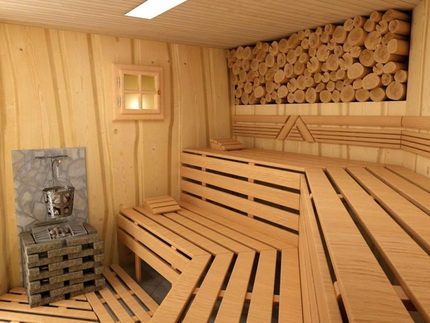
The second factor determining the effectiveness of the system is the relative position of the openings. Since any ventilation system works on the principle of replacing air masses, it is extremely important to be able to regulate these flows. This can be done by choosing the right place for exhaust and supply openings relative to each other or relative to heating appliances.
In addition, you need to take into account the specifics of the bath. Comfortable temperature is especially important here, which can be achieved only in the absence of sharp "horizontal" temperature drops. They are felt when moving from room to room.
The vertical air flow should also move as gently as possible, so that the temperature near the floor is approximately the same as that at the level of the head of a standing person. Otherwise, discomfort is inevitable.
Existing ventilation schemes
The most difficult in terms of arranging ventilation is a steam room or a sink, if their functions are combined. Consider several efficient ventilation schemes for these bath rooms.
Scheme No. 1 - tributary near the furnace
One of the most popular schemes for arranging bath ventilation. The supply opening is carried out at a low height from the floor within 250-350 mm.It should be located in the immediate vicinity of the stove, you can right behind it.
An exhaust opening is installed on the opposite wall near the ceiling. The distance between them should be about 150-250 mm. Then the air masses move in this way.
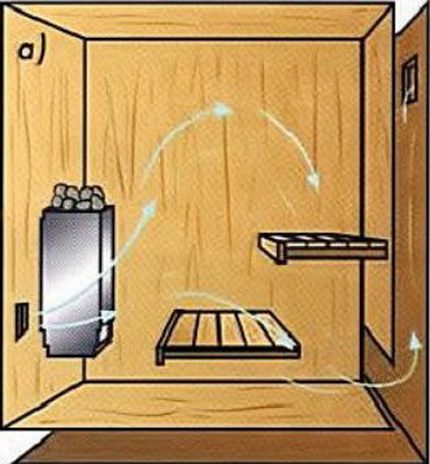
Entering through the supply aperture, the air enters the furnace heating zone, here it displaces the lighter already warmed air masses, which rise to the ceiling and move towards the opposite wall towards the exhaust outlet. Thus, only mixed or warm, as well as hot air flows are present in the room. The maximum heating zone is located under the exhaust opening.
It is here that the shelves are optimally positioned. The advantage of the scheme is that the cold air masses in the room are practically absent, since immediately after ingestion they warm up from the stove.
The circuit is fully functional using natural circulation; it can also work with forced circulation. In the latter case, the exhaust option gives a good effect when a fan is installed in the upper opening.
Its power must be correctly calculated, otherwise the occurrence of drafts with excessive power and slowed-down air circulation cannot be avoided. For the possibility of additional regulation in the supply aperture, it is desirable to install movable blinds, which will allow controlling not only the flow intensity, but also to some extent its direction.
Scheme No. 2 - openings on one wall
It may seem that this is ineffective, but in this case both the exhaust and supply air openings are located on the same wall. Such a scheme works and is indispensable if there is no possibility of arranging openings on different walls.
For example, a bathhouse is equipped in a house and has only one wall facing the street. In this case, the supply aperture is located in the lower part of the wall at a height of about 200 mm from the floor.
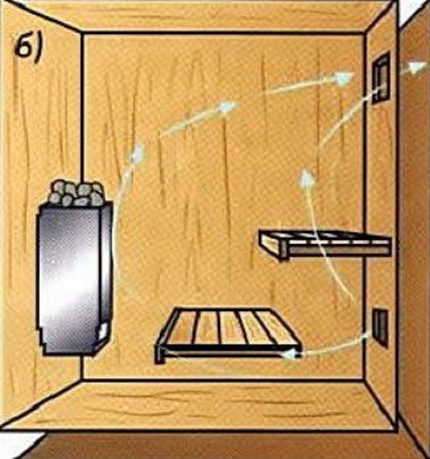
An oven should be installed opposite the supply air inlet. An exhaust opening is arranged above the supply at a distance of about 200 mm from the ceiling. Cool masses of air enter the room and move in the direction furnace. This is due to the principle of convection.
In the area of the stove, a cold stream displaces the heated one, which rises to the exhaust opening in a wide arc covering the entire room.
Thus, the circuit works efficiently. Due to the location of the heater, the incoming supply air flow moves quite intensively, which stimulates air exchange in general. You can install a fan in the hood to somewhat speed up the circulation of air flows. It is recommended to put an adjustable grille on the supply aperture.
Scheme 3 - for a bath with a "wet" floor
The main condition for arranging this scheme is the presence of a multilayer leaking floor. It is assumed that the water goes under the floor and drains into the sewer. In this case, the exhaust opening is arranged directly under the wooden flooring. The hole is connected to an insulated ventilation duct, which exhausts the exhaust air masses into the street.
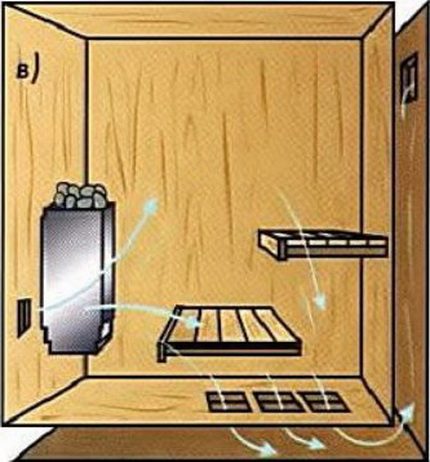
The supply aperture is placed at a small height from the floor, approximately 200-250 mm near the stove. Thus, street air immediately enters the heating zone. Then it rises to the ceiling and slowly cools down there. It sinks to the floor and passes through its cracks.
Thus, it evaporates excess moisture that has fallen on the tree, so the life of the wooden floor is significantly extended. Next, the flow is directed into the exhaust opening.
Using this scheme allows you to achieve the most uniform heating of the room and good evaporation of excess moisture from wooden floors. However, the trajectory of the air mass is very complex.
Natural circulation will most likely not be enough. Therefore, it is recommended to put a fan in the hood. For the same reason, it is also desirable that the specialist calculate the dimensions of the openings and their locations.
Scheme No. 4 - blew in as a hood
In this embodiment, an exhaust opening in the room is not provided. Its role is played by the blowing of the sauna stove. You need to understand that the circuit is only functional if the furnace is heated. Otherwise, air exchange ceases due to lack of traction.
For this reason, the furnace must be flooded throughout the entire time of the bathing procedures. Otherwise, ventilation will be absent.
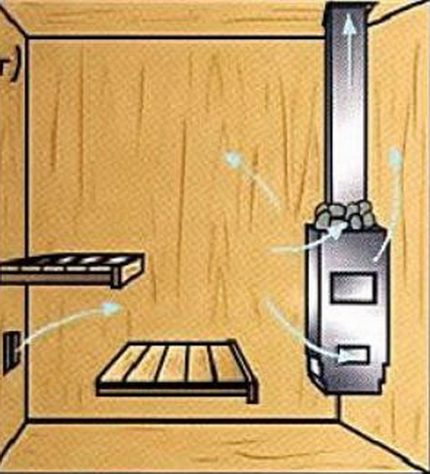
To implement this scheme, the supply aperture is mounted opposite the stove at a low height of about 300 mm from the floor. Air enters the room and moves towards the heater. Here he pushes the heated air masses to the ceiling, which rise and move around the room, thereby warming it. The cooled air descends to the floor and is discharged through the blower of the furnace.
All the circuits described are extremely simple. They involved only two vents: exhaust and supply. This design allows you to adjust the bath microclimate very approximately, but quite efficiently.
More precise settings require complex systems with several ventilation openings located in very different ways relative to each other.
Recommendations for the arrangement of bath ventilation
To improve air exchange inside the bath rooms and extend the life of wooden structures, experts advise you to think about arranging a ventilated floor. For this flooring boards should be laid with some clearance between the elements. It can reach up to 10 mm. Small supply openings, the so-called vents, are laid in the foundation of the building.

Opposite walls also run small vents to help activate air exchange. Important note. These holes must be protected with a metal mesh, otherwise it is possible that rodents will settle in the bathhouse. It is advisable to lower the level of the blown stove below the floor. So in the process of heating, the blower will additionally work as a hood.
If you plan to equip forced ventilation, it is important to correctly select the equipment. It must be remembered that for installation in the bath only special moisture-resistant and heat-resistant devices are suitable.
It is desirable that there is the possibility of regulating their power. So it will be possible to respond as flexibly as possible to changing conditions. For example, in winter with a significant temperature difference, traction will be very good.
The device will be able to operate at minimum power, while in the summer with a minimum difference it will have to operate with greater efficiency. In addition, you should accurately select the type of fan. He can be channel, which is placed inside the duct, or radial. In the latter case, the device is mounted at the outlet of the ventilation shaft.
Another important point is the ventilation ducts. Depending on the type of system and the wishes of the owner, they may be different. The most reliable and durable are the so-called solid products.They are made of galvanized steel or from special plastic.
A slightly less reliable, but easier to install option - flexible ducts. They are made as a corrugated pipe with an inner metal frame.
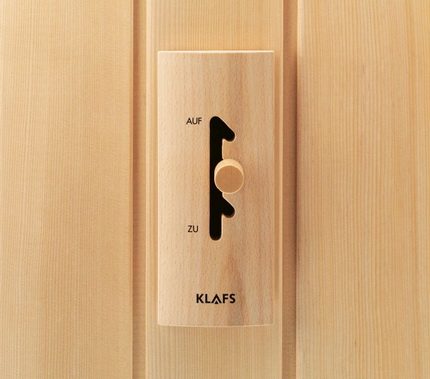
Installation of bath ventilation is not particularly difficult. First, perform all the necessary holes and mount the ventilation ducts. If necessary, fans are mounted inside or outside the box. It depends on the type of device. Further, electrical appliances are connected to the network. The way they are connected depends on the mode in which the fan will operate.
The equipment can turn on automatically as the concentration of humidity and carbon dioxide in the air increases. You can turn it on simultaneously with lighting, using a motion sensor or by pressing a separate key.
Shutdown can be carried out using a timer, then it will come after a predetermined time, or when the lights are turned off.
Conclusions and useful video on the topic
Consider the basic schemes of bath ventilation:
How to arrange ventilation in the washing:
How to dry the bath after use:
The bathhouse is in urgent need of proper ventilation. The safety and comfort of people receiving water procedures and the durability of the building itself depend on it. The arrangement of the system must be performed in accordance with all the rules, planning it at the design stage of the bathhouse.
If the owner finds it difficult to complete the ventilation project on his own, it is worth contacting specialists. Then the new bath will last a long time and it will always be comfortable and safe.
Do you have personal experience in arranging ventilation in a bathhouse? You can share your own methods or ask questions about the topic of the article in the block below.

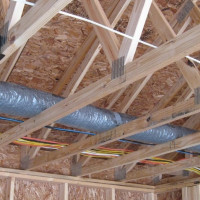 Ventilation in the house from sip panels: the best options and layouts
Ventilation in the house from sip panels: the best options and layouts  Typical schemes and rules for designing a ventilation system in a private house
Typical schemes and rules for designing a ventilation system in a private house 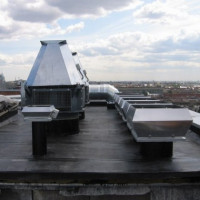 Schemes for arranging ventilation systems in an apartment building
Schemes for arranging ventilation systems in an apartment building 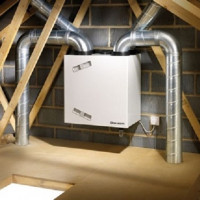 Heat recovery in ventilation systems: operating principle and options
Heat recovery in ventilation systems: operating principle and options  Design and installation of ventilation systems: the best schemes + installation nuances
Design and installation of ventilation systems: the best schemes + installation nuances  Cellar ventilation device with one and two pipes: an overview of important technical aspects
Cellar ventilation device with one and two pipes: an overview of important technical aspects  How much does it cost to connect gas to a private house: the price of organizing gas supply
How much does it cost to connect gas to a private house: the price of organizing gas supply  The best washing machines with dryer: model rating and customer tips
The best washing machines with dryer: model rating and customer tips  What is the color temperature of light and the nuances of choosing the temperature of the lamps to suit your needs
What is the color temperature of light and the nuances of choosing the temperature of the lamps to suit your needs  Replacement of a geyser in an apartment: replacement paperwork + basic norms and requirements
Replacement of a geyser in an apartment: replacement paperwork + basic norms and requirements
To be honest, I came across only natural ventilation in the bath. Well, plus a stove, which serves as a good range hood. I’m not at all sure that a private bath, which is usually used once or twice a week, really needs some kind of special ventilation. Washed, then ventilated the bath, that's all the ventilation. Perhaps the fact is that I only steamed in a Russian bath and I do not know how others work.
He built a bathhouse on his own. In general, it turned out not so bad, the only thing - with the ventilation device miscalculated. Condensation began to appear. With a friend, we decided to make an additional window with a window. Plus, after going to the bath, we remove excess moisture from the ceiling with a rag. Of course, it was not possible to solve the problem completely, but the time for drying began to take less.